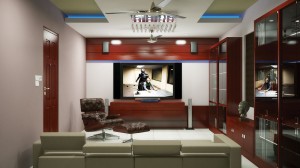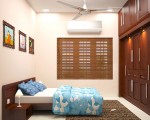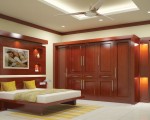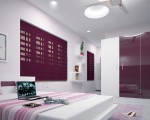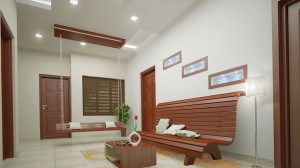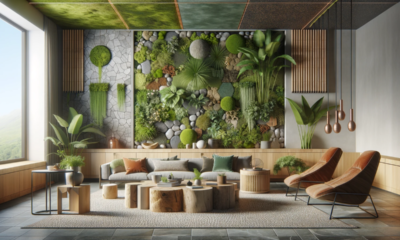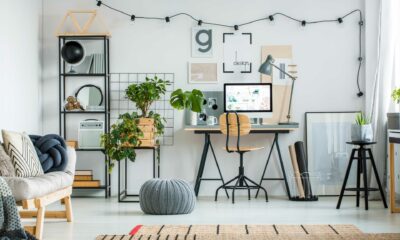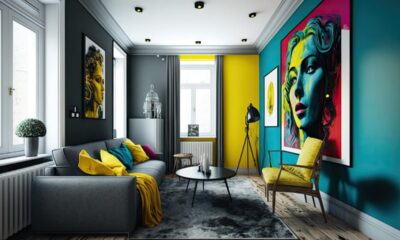Architecture
Blended in perfection
Achieving a design harmony is an important part while doing a home. A contemporary feel was brought in while doing this home by keeping the traditional aspect alive
Achieving a design harmony is an important part while doing a home. A contemporary feel was brought in while doing this home by keeping the traditional aspect alive
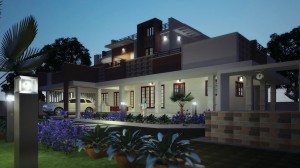 Everyone have their own credo about the style and functionality of their home interiors. Spacious feel, functional design and ample positive energy seem to be the key word of many new home owners. Mr. Gopalakrishnan too had all these in his mind, but in addition to that he wanted a contemporary interior without leaving the essential Indianness. Mr. Premdas, Chief Designer of Monnaie Interiors was successful in infusing all these elements as per the wish of the client who was so precise about his requirements. As per the client’s requirement, all modern accessories come with a bit of Indian tradition blended with it.
Everyone have their own credo about the style and functionality of their home interiors. Spacious feel, functional design and ample positive energy seem to be the key word of many new home owners. Mr. Gopalakrishnan too had all these in his mind, but in addition to that he wanted a contemporary interior without leaving the essential Indianness. Mr. Premdas, Chief Designer of Monnaie Interiors was successful in infusing all these elements as per the wish of the client who was so precise about his requirements. As per the client’s requirement, all modern accessories come with a bit of Indian tradition blended with it.
This being the design concept, this 4434 sq ft home features a perfect restful and spiritual retreat.
Foyer
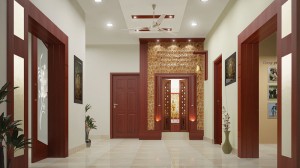
The key aspect of the project is well reflected here. The foyer is about 201square feet and is the main allure of the interiors. The client who had a spiritual inclination wanted to create a feeling of positive energy, elegance as well as a spiritual feel to someone entering the house.
The foyer gives the feel of a prayer hall and is independent from other rooms. The lighting of the area makes it apt. The wall cladding in front of the prayer hall with small pieces of coconut shells is the wow factor here.
Living Room
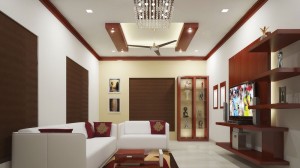 The living room is simple, well arranged and creates a lasting impression for all who enter the house. The LCD unit maintains a vast music collections and a provision for curious. Light coloured sofa and direct lighting in conjunction with indirect illumination adds to the elegance of the room.
The living room is simple, well arranged and creates a lasting impression for all who enter the house. The LCD unit maintains a vast music collections and a provision for curious. Light coloured sofa and direct lighting in conjunction with indirect illumination adds to the elegance of the room.
A warm appeal to the room is maintained with an overall beige dominant theme.
The walls are painted with light beige with two wall contrast; the contrast wall is painted a shade of yellow and orange mix. The ceiling work is done with 12mm gypsum board, provided for indirect illumination. The entry to the living room is through a contemporarily styled sliding door.
Dining Area
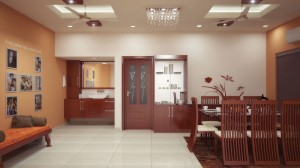 It is the same pattern as that of the living room – a light orange colour with beige tone for walls, and ample wooden finish. Family photos arranged in an asymmetrical manner add to the beauty of the wall.
It is the same pattern as that of the living room – a light orange colour with beige tone for walls, and ample wooden finish. Family photos arranged in an asymmetrical manner add to the beauty of the wall.
This is designed as a sort of combination of AV room and a reading room. Regarding the lighting of the interiors, the client wanted his interiors to be bright; and cove lights are used along with a
square modern chandelier. A reclining type sofa here adds luxury and comfort. The wall colours are a combo of dark maroon with light hue of maroon.
Kitchen
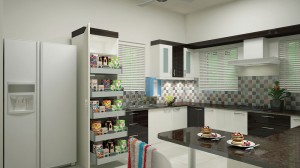 The kitchen here is modular; a U shaped one with multi utility facilities. The kitchen has a breakfast counter and a utility area which is equally eloquent. Kitchen is made using high quality BWP plywood with MR+ laminations from Merino Laminates due to the fact that it is totally scratch proof and is easy to clean. The colour combo used in the kitchen is slightly different from the other designed areas; and executed in a total modern outlook with an off white color as whole and choco brown laminate (elevated wood) for contrast. The wall tiles also syncs with the design.
The kitchen here is modular; a U shaped one with multi utility facilities. The kitchen has a breakfast counter and a utility area which is equally eloquent. Kitchen is made using high quality BWP plywood with MR+ laminations from Merino Laminates due to the fact that it is totally scratch proof and is easy to clean. The colour combo used in the kitchen is slightly different from the other designed areas; and executed in a total modern outlook with an off white color as whole and choco brown laminate (elevated wood) for contrast. The wall tiles also syncs with the design.
Bedrooms
Two master bedroom are classy, spacious and with wide wardrobes. The colours are warm but the wood tone highlights more. Wardrobes are designed in a semi traditional style.
The guest bedroom is a simple and well-arranged one designed for elderly. High ceiling is the main factor for this room they want to feel the sense of space everywhere. The mural paintings in the room enhance the traditional look.
The daughter’s room (teen room) has a splash of her favourite colour pink and a little bit funky like a princess abode. It has more contemporary tone especially with the book shelf, and ceiling.
Lobby was differentiated from other areas and the walls and curios catch the attention. A wooden finished swing gives a touch of tradition within the simple modern outlook.
Even the landscaping of the house is done within these key points- a green belt concept with modern lighting and paving tiles with a contemporary outlook.
Project : Individual House
Owned by : Mr. Gopalakrishnan and Family
Location: Palakkad, Kerala
Plot area: 20 cents
Total floor area: 4434 sq ft
Architecture & Design: Premdas Krishna, Monnaie Interiors. Contact: 9447434237
Photographs: Monnaie Interiors
Architecture
5 Sustainable Interior Design Trends to Embrace in 2024
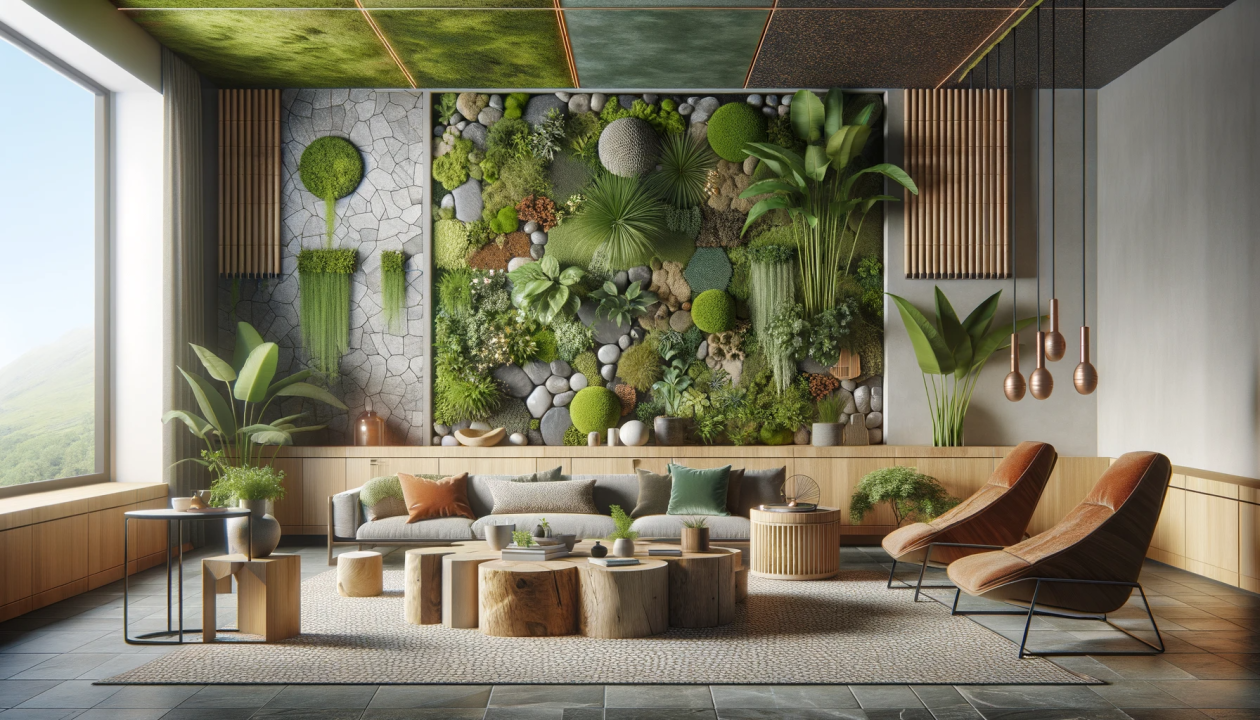
As the world becomes increasingly aware of the importance of sustainability, it’s no surprise that eco-friendly practices are making their way into the realm of interior design. In 2024, we can expect to see a surge in sustainable interior design trends that not only enhance the beauty of our living spaces but also minimise our environmental footprint. From repurposed materials to energy-efficient solutions, here are five sustainable interior design trends to embrace this year.
Upcycled Furniture:
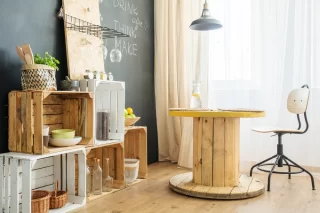
One of the most prominent sustainable interior design trends of 2024 is the use of upcycled furniture. Instead of buying new pieces, consider giving old furniture a new lease on life by refurbishing or repurposing them. From reclaimed wood tables to refurbished chairs, upcycled furniture adds character and charm to your space while reducing waste and conserving resources.
Biophilic Design:
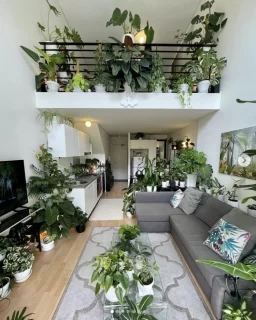
Biophilic design, which emphasizes a connection to nature, continues to gain popularity in 2024. Integrating natural elements such as plants, natural light, and organic materials into your interior design not only enhances aesthetics but also promotes well-being and sustainability. Consider incorporating living walls, indoor gardens, and sustainable wood finishes to bring the outdoors inside and create a healthier living environment.
Energy-Efficient Lighting:
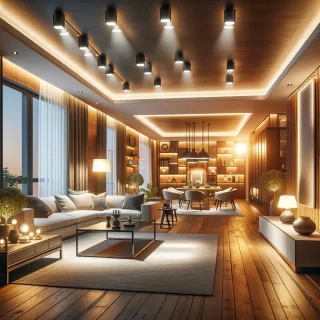
With a growing focus on energy conservation, energy-efficient lighting solutions are becoming a staple in sustainable interior design. LED lights, in particular, consume significantly less energy than traditional incandescent bulbs and last much longer, reducing both energy consumption and maintenance costs. Additionally, consider incorporating natural light sources such as skylights and large windows to maximize daylight and minimize the need for artificial lighting during the day.
Sustainable Textiles:
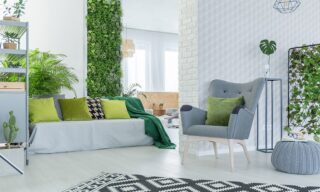
When it comes to upholstery and soft furnishings, opting for sustainable textiles is key to reducing environmental impact. Look for fabrics made from organic or recycled materials, such as organic cotton, hemp, bamboo, or recycled polyester. These materials not only reduce the use of harmful chemicals and pesticides but also minimize waste and support eco-friendly production practices. Additionally, consider investing in durable, high-quality textiles that stand the test of time, reducing the need for frequent replacements.
Smart Home Technology:
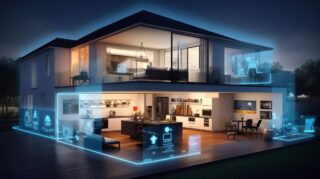
In 2024, smart home technology continues to evolve, offering innovative solutions for sustainable living. From smart thermostats that optimize energy usage to home automation systems that control lighting and appliances, these technologies can help reduce energy consumption and increase efficiency in your home. Additionally, smart home devices such as occupancy sensors and smart meters provide valuable insights into your energy usage, empowering you to make informed decisions about resource management and conservation.
As we strive to create more sustainable living environments, embracing these five interior design trends can help reduce our environmental impact while creating beautiful and functional spaces. Whether you’re upcycling old furniture, incorporating natural elements, or investing in energy-efficient technologies, every sustainable choice contributes to a greener future for generations to come. So let’s embrace these trends and make sustainability a cornerstone of our interior design practices in 2024 and beyond.
Architecture
Designing a Functional Home Office: Tips for Productivity and Comfort
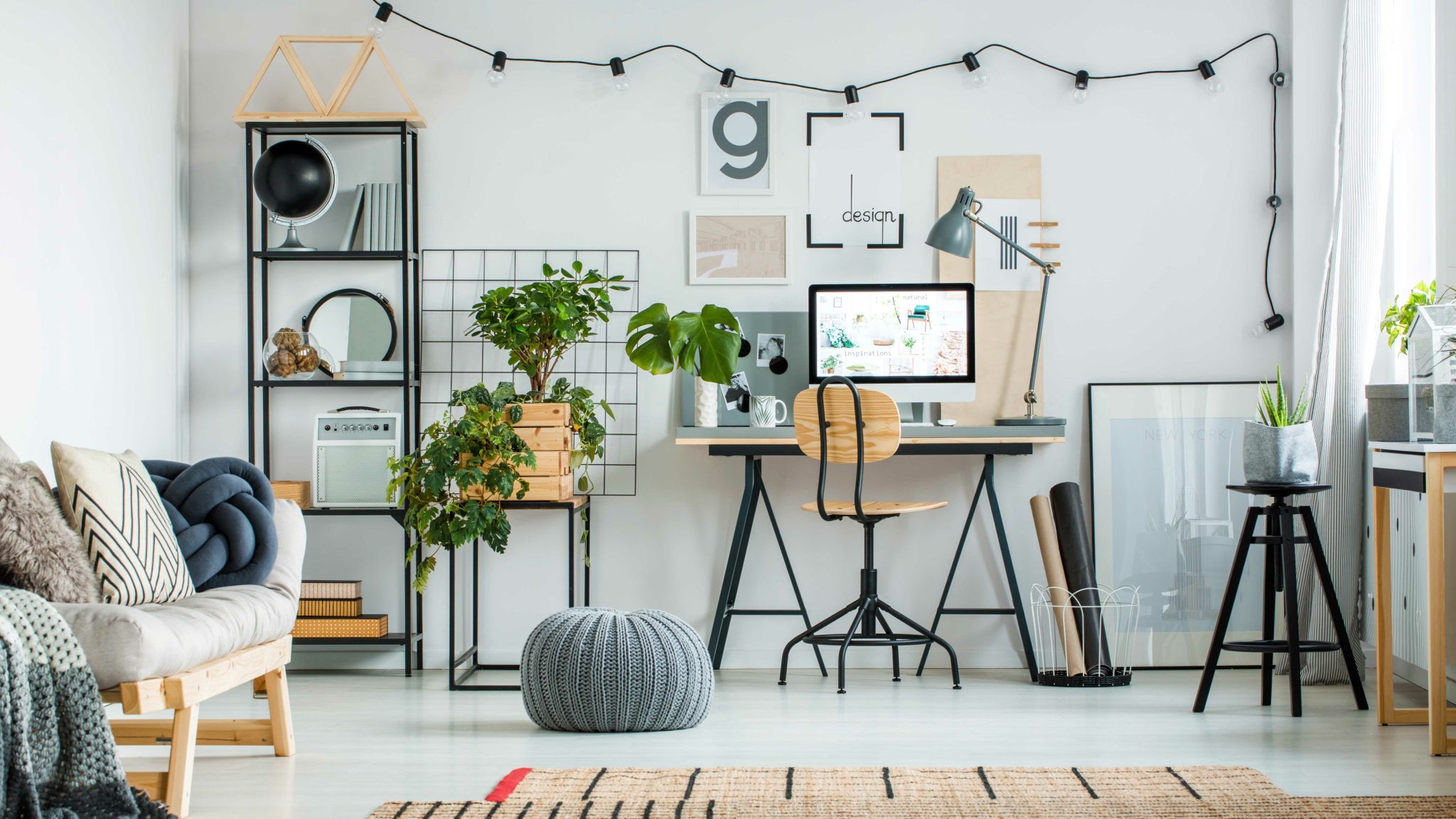
In today’s ever-evolving work landscape, the home office has become an essential sanctuary for productivity and creativity. Whether you’re a remote worker, freelancer, or entrepreneur, designing a functional home office is paramount for maintaining focus, maximizing efficiency, and enhancing overall well-being. Here are some expert tips to help you create a workspace that promotes productivity and comfort:
Choose the Right Location
Select a quiet and well-lit area in your home that is conducive to work. Ideally, this space should be away from distractions like heavy foot traffic or noise from common areas.
Invest in Ergonomic Furniture
Your office chair and desk are vital components of your workspace. Invest in ergonomic furniture that promotes good posture and reduces the risk of discomfort or injury during long hours of work.
Prioritize Natural Light
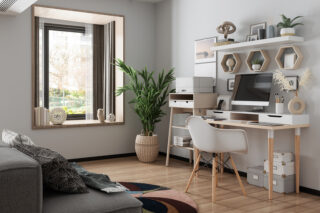
Position your desk near a window to take advantage of natural light. Natural light not only enhances mood and energy levels but also reduces eye strain and fatigue.
Declutter Regularly
Keep your workspace clutter-free by organizing cables, files, and supplies. A clean and organized environment fosters clarity of mind and helps minimize distractions.
Personalize Your Space
Incorporate elements that inspire and motivate you, such as artwork, plants, or motivational quotes. Personalizing your space can boost creativity and make your home office feel more inviting.
Optimize Technology Setup
Ensure that your technology setup including your computer, monitor, keyboard, and mouse is optimized for efficiency and comfort. Consider investing in accessories like an adjustable monitor stand or a wireless keyboard and mouse for added flexibility.
Incorporate Greenery
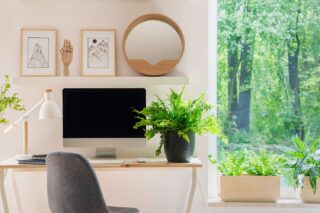
Introduce plants into your home office to improve air quality and add a touch of nature to your space. Plants not only enhance aesthetics but also have been shown to reduce stress and increase productivity.
Create a Distraction-Free Zone
Minimize distractions by setting boundaries with family members or roommates and establishing specific work hours. Consider using noise-canceling headphones or a white noise machine to block out unwanted sounds.
By implementing these tips, you can design a home office that promotes productivity, creativity, and overall well-being. Remember that every individual’s needs and preferences are unique, so feel free to experiment and adjust your workspace to suit your specific requirements. With a well-designed home office, you’ll be better equipped to tackle your tasks with focus, efficiency, and comfort.
Architecture
A Guide to Choosing the Perfect Colors for Your Home Interior

Your home is your sanctuary, and choosing the right colors for its interior can significantly impact the atmosphere and ambiance of each room. Whether you’re looking to create a cozy retreat, a vibrant living space, or a serene oasis, selecting the perfect color palette is key. In this guide, we’ll walk you through the process of choosing the right colors for your home interior to reflect your personal style and create a harmonious living environment.
Consider the Mood You Want to Create:
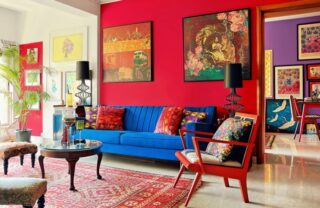
The first step in choosing the right colors for your home interior is to consider the mood or atmosphere you want to evoke in each room. Do you prefer a calming and serene space, or are you looking for something more vibrant and energizing? Think about how you want to feel when you’re in each room and choose colors that align with those emotions.
Take Lighting into Account:
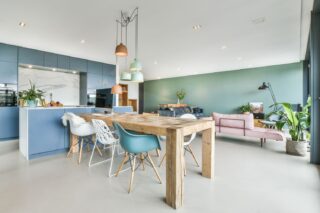
Lighting plays a crucial role in how colors appear in a room. Natural light can enhance certain hues while making others appear dull. Consider the direction and intensity of natural light in each room when choosing paint colors. Rooms with ample natural light can handle bold and vibrant colors, while those with less light may benefit from softer, lighter shades.
Create a Cohesive Color Scheme:

To ensure a cohesive flow throughout your home, choose a consistent color scheme that ties all the rooms together. You can achieve this by selecting a few key colors and using them in different combinations throughout the house. Neutral colors like whites, grays, and beiges make excellent base tones, while accent colors can add pops of personality and interest.
Explore Color Psychology:
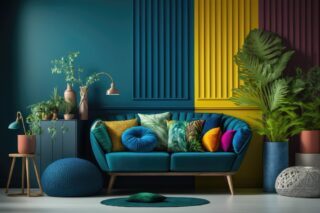
Color psychology can help you understand how different colors can affect mood and behavior. For example, blue is often associated with calmness and tranquility, making it an excellent choice for bedrooms and bathrooms. Yellow, on the other hand, can evoke feelings of happiness and energy, making it ideal for kitchens and living areas. Consider the psychological effects of each color when making your choices.
Test Paint Samples:
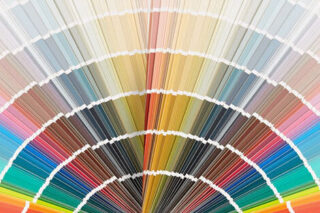
Before committing to a color for your walls, it’s essential to test paint samples in the actual space. Paint a small section of the wall with your chosen colors and observe how they look throughout the day in different lighting conditions. This will help you make an informed decision and ensure that you’re happy with the final result.
Don’t Forget About Accents and Accessories:
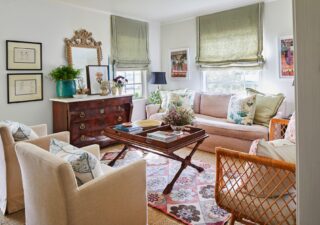
In addition to wall colors, consider how accent pieces and accessories can complement your chosen color scheme. Throw pillows, rugs, curtains, artwork, and furniture upholstery can all add depth and dimension to your space while tying the room together visually.
Choosing the right colors for your home interior is a personal and creative process that can transform your living space into a place you love to call home. By considering the mood you want to create, taking lighting into account, creating a cohesive color scheme, exploring color psychology, testing paint samples, and incorporating accents and accessories, you can design a home that reflects your unique style and personality. So, let your creativity flow, and enjoy the process of bringing your vision to life!
-

 Entertainment3 months ago
Entertainment3 months agoThe Stunning looks from Bhagya Suresh’s Wedding
-

 Fashion3 months ago
Fashion3 months agoMost Discussed Ajrakh Saree of Alia Bhatt
-

 Entertainment3 months ago
Entertainment3 months agoThe Most Stylish Guests of Bhagya Suresh Reception
-

 Entertainment3 months ago
Entertainment3 months agoEverything about the Ira Khan wedding that is out of the norm
-

 Entertainment3 months ago
Entertainment3 months agoBridal Bliss : All Bridal Looks of Swasika Vijay
-

 Entertainment3 months ago
Entertainment3 months agoAll About The Dreamy Pre Wedding Invite Of Anant Ambani & Radhika Merchant
-

 Fashion3 months ago
Fashion3 months agoMajor Denim Trends You Need To Know in 2024
-

 Entertainment3 months ago
Entertainment3 months agoBest Looks from Golden Globes 2024

